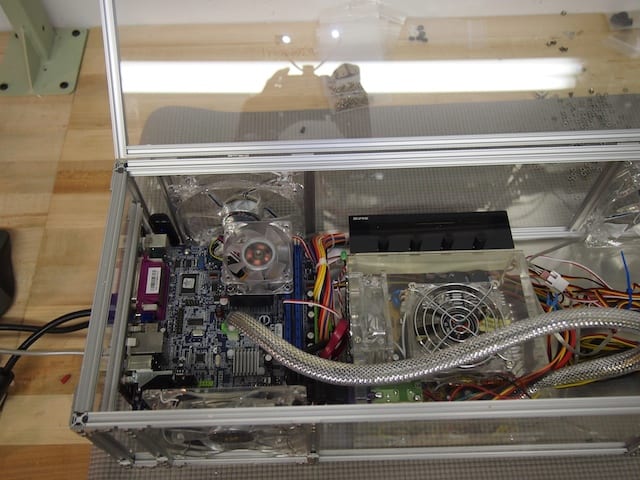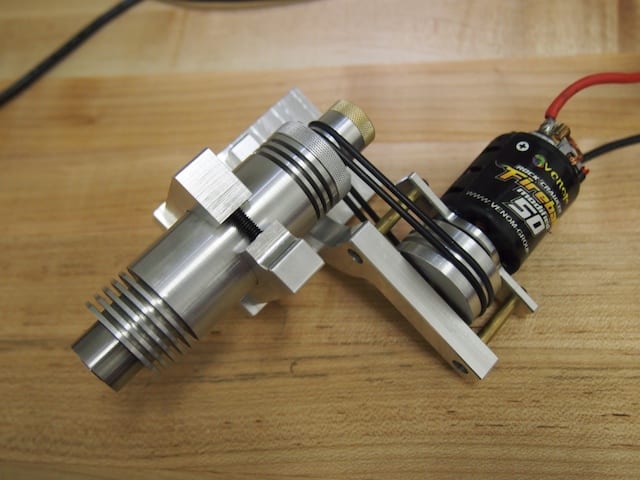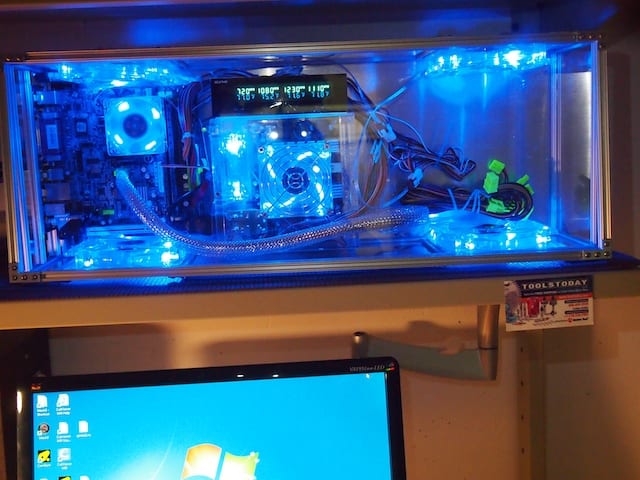Up to this time, we’ve been using hand tools to build our robots. But over the last few months, we’ve been working on building a Computer Numerical Control Machine (CNC) that will allow us to precisely cut, drill, and machine aluminum, brass, plastic, wood, and other materials.
Part of this project is to design and build a custom electronics enclosure that will be a combination computer / CNC / motor control system. This will be the “brain” of the CNC. After trying a few different approaches, we decided to build the box from scratch out of 1/8″ acrylic sheet and Microrax, with are tiny, 10mm 80/20 aluminum beams. The enclosure is about 22″ long, 12″ wide, and 8″ deep. The beauty of Microrax is that we could easily cut the beams to the size we wanted and then use small machine screws and brackets to bolt them together. This allowed us to not only construct the overall enclosure, but to bracket the four cooling fans into place, frame the I/O ports, and add an acrylic lid with hinges. MicroRax is very flexible and cool stuff that I look forward to using for future projects, not only for enclosures, but robots as well.

On the left side of the enclosure we mounted a mini-ITX motherboard, a small SSD hard drive (not visible in this picture because it’s under the motherboard), the RAM (blue), an internal USB hub, ports for communication with the motor controller, and various other computer components. In the center of the enclosure we installed the main power supply (clear) and the fan control system (black). The right side of the enclosure will contain the motor control boards and other CNC-specific components (which we haven’t installed yet).

There are four main enclosure fans (two on the top and two on the bottom) and four smaller internal fans.

Here is the CNC Electronics Enclosure in the workshop, along with the screen, keyboard, and mouse. We will most likely be mounting the enclosure on the wall so that the lower two fans are more effective.[/caption]
In this close-up, you can see that the fan control system displays the rpm speed of each fan and allows you to adjust it. It also displays the temperature of the corresponding sensor. We’ve attached the sensors to the microprocessor heat sink, the RAM, the motor controllers, and other critical components.[/caption]
Here are various parts for the CNC that we’ve been working on, including the CNC’s aluminum T-Slot table, various fixtures, the largest of the three interchangeable spindles the CNC will use (for 1/4-inch end mills), and a block of blue machinable wax.

Here is a close up of the smallest spindle the CNC will use. This is a high-precision 1/8-inch spindle for delicate work. It will be driven at a spindle speed of 25,000 rpm by the brushed motor via the two black belts, which in turn will be controlled by the motor controller, which in turn will be controlled by the CNC software running on the computer. At least theoretically! Keep your fingers crossed! :)[/caption]




The 1/8″ spindle is from Richard, who machines spindles, steam turbines, miniature steam engines, and other cool stuff. Check out his website here: http://www.wolfgangengineering.com/
I’ve wired up the 1/8″ spindle and I’ve been experimenting with it, and so far it seems excellent.
The other spindle is a motor from a Dewalt 611 variable speed router that I took apart. It’s a much bigger beast than the Wolfgang Engineering spindle. My plan is for my CNC to have mounting flexibility for several different types of spindles depending on the job. The smaller spindle seems to be far more precise and better suited for circuit boards and fine work. I assume the Dewalt will be good for hogging out a lot of metal. Although, I may find that I end up liking one of the various spindles more than the other and then just stick with that. We’ll see how it goes.
Hello Camille,
Great looking build. Looking forward to seeing all the progress.
On your 1/8″ spindle is that a home build? If not would you be willing to share your source?
Thanks!
Houston: I’m glad you like it. The MicroRAX beams connect together using little tiny brackets and hex button machine screws that you buy on the MicroRAX site (or buy a large kit from Sparkun or other retailer). I cut the back piece out of a sheet of 0.063 aluminum. Then I drilled holes into it to mount the motherboard and transparent power supply. The motherboard is on standoffs. The SSD hard drive is mounted underneath it. The power supply is machine screwed directly to the aluminum sheet with no standoffs (the power supply has threaded holes for that purpose). I mounted the motherboard so that the I/O shield was flush to one side of the case. The I/O shield and fans I framed with cross beams, which looks cool and works well, especially combined with the acrylic. When you cut them to size, the acrylic sheets fit exactly into the slot of the MicroRAX. It wasn’t designed for that, but it works very nicely and looks professional. I use a Proxxon 4″ table saw to cut the aluminum, acrylic, and MicroRAX beams. Any small-sized table saw with a metal/acrylic-cutting-blade and a good fence (so that your cuts are straight) will do the trick. I hope all that helps. Let me know if you need more info.
I’m considering building a custom ITX case using MicroRAX after seeing this.
May I ask you for more details about how the various components are secured to the frame or panels? Of particular interests are the motherboard and I/O shield, the fans, and the power supply. Thanks!
Thank you for the detailed description, it helps tremendously!
It’s really a great and useful piece of information. I’m happy that you simply shared this useful information with us. Please keep us up to date like this. Thank you for sharing.
We’re a bunch of volunteers and starting a new scheme in our community. Your website provided us with valuable info to work on. You’ve done a formidable job and our entire community will be grateful to you.
Wow! Your CNC machine looks amazing!
Benjamin (7 years old) and Dad, from Chile.
Great project! I am interested in one small aspect of it. I teach automated systems at a community college and I’m looking for a good supplier for T-slot tables and associated hardware for mounting various components. Can you tell me where you got the aluminum T-slot table shown in one of the pictures above? Thanks.
Jim: Thank you. Regarding the T-slots:
I would recommend connecting several wide, flat T-slots from 8020.net.
Also, you could use the x90 T-slot shown on this page: http://www.probotix.com/accessories/